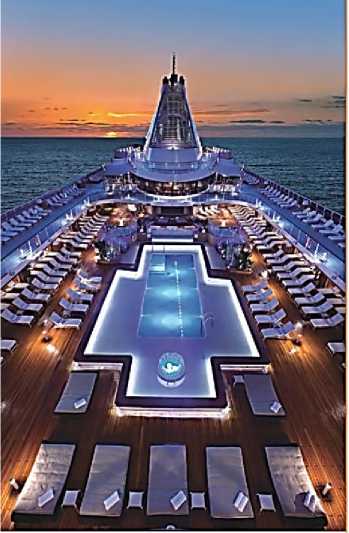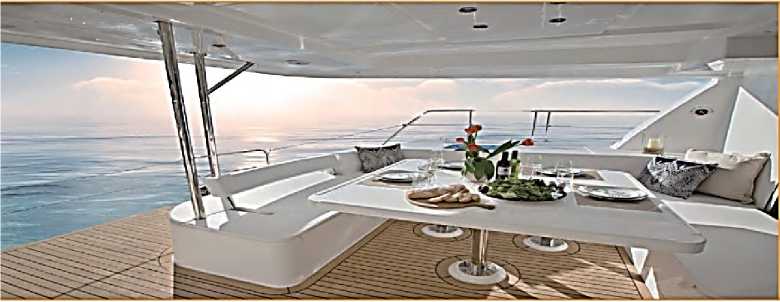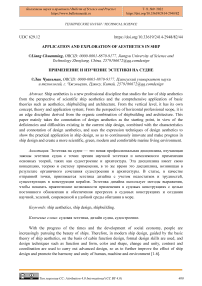Application and exploration of aesthetics in ship
Автор: Liang Chuanming
Журнал: Бюллетень науки и практики @bulletennauki
Рубрика: Технические науки
Статья в выпуске: 9 т.8, 2022 года.
Бесплатный доступ
Ship aesthetics is a new professional discipline that studies the law of ship aesthetics from the perspective of scientific ship aesthetics and the comprehensive application of basic theories such as aesthetics, shipbuilding and architecture. From the vertical level, it has its own concept, theory and application system; From the perspective of horizontal professional scope, it is an edge discipline derived from the organic combination of shipbuilding and architecture. This paper mainly takes the connotation of design aesthetics as the starting point, in view of the deficiencies and difficulties existing in the current ship design, combined with the characteristics and connotation of design aesthetics, and uses the expression techniques of design aesthetics to show the practical application in ship design, so as to continuously innovate and make progress in ship design and create a more scientific, green, modern and comfortable marine living environment.
Ship aesthetics, ship design, shipbuilding
Короткий адрес: https://sciup.org/14124813
IDR: 14124813 | УДК: 629.12 | DOI: 10.33619/2414-2948/82/44
Текст научной статьи Application and exploration of aesthetics in ship
Бюллетень науки и практики / Bulletin of Science and Practice
UDC 629.12
With the progress of the times and the development of social economy, people are increasingly pursuing the beauty of ships. Therefore, in modern ship design, guided by the basic theory of ship aesthetics, on the basis of cabin function design, formal design skills are used, and design techniques such as function and form, color and shape, change and unity, contrast and coordination are used to carry out advanced design, so as to further improve the effect of ship design and promote the harmony and unity of human, machine and environment [1-6].
Essence of design aesthetics
Design aesthetics is an applied aesthetics discipline that integrates aesthetic principles with design theory and application in modern design, and integrates aesthetics and art research. It has a unique theoretical cognition and system in the aesthetic law, research object and research scope of design. The most essential connotation of design aesthetics is the organic integration of technical beauty, functional beauty, formal beauty, artistic beauty and other categories [1].
Design aesthetics mainly includes four characteristics: technical beauty, functional beauty, artistic beauty and formal beauty. Technological beauty is to integrate human emotions and needs into technological products in modern design, and re create technology and wisdom by applying natural laws and aesthetic concepts. Functional beauty not only shows and meets the actual use needs of things, but also shows the relationship between China and the United States and goodness in the field of material production. Artistic beauty is the display and transmission of various social functions through aesthetic transmission and image expression, which mainly includes three elements: color, shape and decoration. Formal beauty refers to the aesthetic value produced by the formal factors of things and the structural relationship of forms. Its expression rules mainly include change and unity, contrast and coordination, symmetry and balance, proportion and scale, rhythm and rhythm, etc.
Aesthetic analysis of the design of Changjiang No.2 ship
Changjiang II is a top-level inland cruise ship carefully built with reference to the standard of five-star cruise ships at sea. The ship is headed by Mr. zhongshoudao, a well-known domestic ship designer. Its main technical indicators have created the world's largest inland cruise ship. In terms of process construction and decoration quality, the ship has fully reached the platinum five-star cruise ship standard, representing the top level of inland luxury cruise ships in the world today (Figure 1).
Features:
-
1. Open, luxurious and magnificent public areas.
-
2. Sunshine observation deck with the largest area and the most complete functions on the Yangtze River.
-
3. The imperial restaurant and Kunlun restaurant can have meals at the same time, and the per capita dining area is the largest in the world of inland river luxury cruise ships
-
4. The multi-function hall with the highest internal space in the Yangtze River cruise ship
-
5. River View Guest Room
On the basis of the standards of the appearance design of mobile building ships, the demand for "personality and comfort" is increasing. At the same time, aesthetic ideas are gradually emerging in the appearance design of cruise ships. Traditional aesthetic elements and modern design styles are shown in the overall functional facilities construction, and modern, simple, fashionable and elegant linear design styles are reflected in the appearance design (Figure 2).
Tourists have a high demand for the sailing experience of cruise ships. Cruise ships sail on the sea like pearls floating on the sea. The atrium space of the ship creates a romantic and warm atmosphere and gives tourists a comfortable and warm travel experience to adapt to the long sailing journey and adjust passengers' mood. The modern simple European design style is well displayed in the atrium design [2, 3].
Reasonable scale and appropriate proportion relationship are the basis of the actual aesthetic effect of ships, which should be considered comprehensively and uniformly. The coordination and unity of the two is one of the necessary conditions for creating perfect beauty. Reasonable size and good visual proportion must be based on the functions given by the ship type, and the proportion and scale cannot be considered in isolation, ignoring the close relationship between them and functions.

Figure 1. Appearance of Changjiang II
Figure 2. Internal design
The design of the ship restaurant is mainly in Chinese style. The suspended buildings and window tracers are designed as partitions of the dining places. The design style of wooden roofs, cornices and corridors reflects the cultural connotation of Chinese traditional catering. Chinese tables and chairs are equipped with minimalist tableware, combined with fresh and elegant music, to create a spatial artistic conception of a dream Jiangnan Water Town.
The general principle of ship interior design is applicable, comfortable, reasonable and safe. In the design, we should fully consider the functional requirements of the cabin and the hobbies and habits of users, and deeply study how to integrate the use requirements with the cabin functions. The key of ship cabin design is that the internal space and environment can effectively serve the cabin function, give full play to the use function of the cabin, and integrate various forms of beauty into the internal function (Figure 3, 4).
Comfort and functionality are the main considerations in the design of the ship family connecting room. The delicate soft decoration in the mobile space hull creates a romantic and warm atmosphere and a feeling of being at home. The cabin space is narrow, and the walls and ceilings are white and light yellow to extend the visual space and reduce the sense of depression; Dark colors such as ochre and Brown are used on the ground and felt to enhance the stability of visual psychology; The anti-vibration and anti-noise measures for the connection between furniture and the hull are adopted to enhance the safety and firmness. The neoclassical style high-quality leather sofa, high-density sponge mattress and other furniture focus on the white and blue color system unified with the hull [5, 6].

Figure 3. Restaurant Design
Figure 4. Guest room design
In the overall design of the hull, color design is the core content of the hull design. Facing different areas, choosing different color systems and different color combinations often gives unexpected results.
The outdoor swimming pool of the hull is between the sea and the blue sky, embedded in the sea like pearls and shells. The Yellow pool shore color system is designed. The clear swimming pool water body is more prominent under the light blue ocean, allowing passengers to enjoy swimming, rest and relaxation on the way of floating navigation (Figure 5).

Figure 5. Terrace design 1
The open terrace is integrated with the external environment of the hull. The compact and smooth design is equipped with white upholstered seats and sofas. The terrace design is integrated with the external environment of the sea. Tourists can have a better leisure experience by resting here and enjoying the beautiful scenery along the way (Figure 6).

Figure 6. Terrace design 2
The space design of the ship, a mobile building on the water, has designed a special hull space under the guidance of inclusive aesthetics. The function (applicability, rationality) of mobile building requires matching appearance, material, visual effect, etc. The space design of mobile building ships adds the requirements of functionality, stability, seakeeping, speed, etc. on the basis of aesthetics, which realizes the combination of aesthetics and space design of mobile building ships.
Adhere to the coordination and unity of design and function. In the interior design of the ship, it is necessary to meet the form, color and shape design of the crew's living quarters and public space environment in different regional environments, adhere to the people-oriented design concept, and organically coordinate and unify the design by integrating the functional type of the ship, the working regional environment, the personality needs of the crew, the national or ethnic factors of the crew, etc.
With the awakening and improvement of people's environmental awareness and environmental protection awareness, the concept of green design has not only been widely used in land environmental design, but also gradually attracted attention in ship interior design, becoming a higher standard pursued by ship interior designers. Deepening the concept of green design in ship design mainly includes the following aspects: joint development of new interior materials, distribution and combination of spatial functions, healthy color configuration design, and continuous integration with natural ecology.
As a mobile micro living and working circle on the sea, various control systems and equipment, workspace, living environment and personnel form a huge and complex human machine environment system. The interaction between human and equipment, human and natural environment, human and internal space, and equipment and working environment form a highly complex but highly coordinated organic system. Ergonomics is to study the coordinated relationship between objects and people, starting from people's fundamental needs and behavior scale, integrate internal and external environmental factors, and apply environmental psychology, design aesthetics and other ideas to unify cabin planning, so that the surrounding environment can better serve people and equipment, so as to achieve the purpose of improving human-machine efficiency. Main research and application directions: analyze the relative position of people and determine the cabin size; Measure the action domain of human body and determine the spatial position of furniture and equipment; Analyze the moving line and reasonably arrange furniture and equipment; Combined with human body size, optimize furniture size and improve performance.
The overall coordination and comfort of the environment is the soul of the interior environment design of the ship, and the design aesthetics is the guideline and implementation method to lead the cabin environment to achieve the organic integration of coordination, comfort and beauty. The reasonable integration of the characteristics and connotation of design aesthetics in the ship interior design and the full use of the expression methods of design aesthetics can effectively improve the scientist fixity, applicability and aesthetics of cabin design, create a comfortable living and working environment, improve the crew's work efficiency and living comfort, and finally achieve the harmony and unity of man machine environment. The interior design of ships also needs continuous innovation and progress, further deepen the application of green design and ergonomics, and create a more scientific, green, modern and comfortable marine living environment.
Список литературы Application and exploration of aesthetics in ship
- Qiu Jingyuan, Jiangbin Introduction to design. Beijing: China Construction Industry Press, 2012.
- Jiao Chenggen Appreciation of design art. Changsha: Hunan University Press, 2004.
- Under construction Ship aesthetics and interior design. Shanghai: Shanghai Jiaotong University Press, 2011. №05.
- Zhu jieying Chromatics - color design and matching. Beijing: China Youth Publishing House, 2004.
- Qiu Guoqiao Research on aesthetic thought in space environment design of mobile building ships // Construction economy. 2021. №1. P. 151-152.
- Chen Xunmei, Gong Rongkun Application of ship aesthetics in the design of ship cabin environment. P. 168-175.


